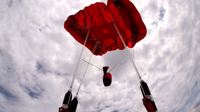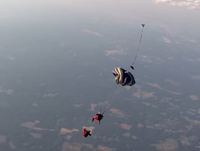The fourth session focused on discussing turbulence and negotiating variable wind conditions. We also discussed vertical speed (how fast you are coming down) and horizontal speed (how fast you are moving across the ground).
Scott explained the calculation of turbulence zone around an obstacle. In addition to the turbulence that results as air passes over an object, we also needed to consider the turbulence above and in front of an object. If a building is 40 feet tall, you can encounter turbulence flying 80 feet above the building (2 times the height). Upwind of the building, you can encounter turbulence within 40-80 feet from the building. On the downwind side, the effect is most substantial, occurring as far as 10 times the height of the building or 400 feet away.
Our final discussion was focused on the glide - true glide and relative glide. Understanding glide, can help you recover from a long spot. Depending on the type and size of your canopy and your wingloading, you can use variable brake pressure to determine which allows you to cover the most horizontal distance. You can also use your rear risers and compare to see which works best for you. Flying some canopies in full glide can decrease the horizontal distance covered. As you pull down on your brakes (or your rear risers), you change the angle of attack. As a result, you can cover more horizontal distance.
At the end of the class, we said our goodbyes and Scott gave me a hug. It only takes one person to change your opinion of a place. For the first time, I felt welcome at Skydive DeLand.



